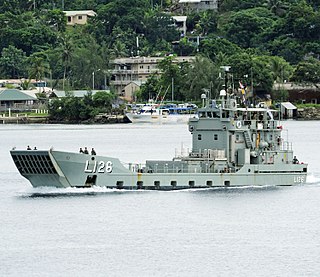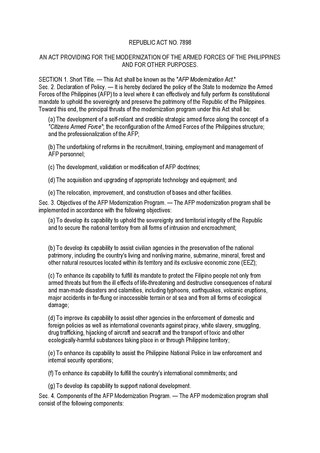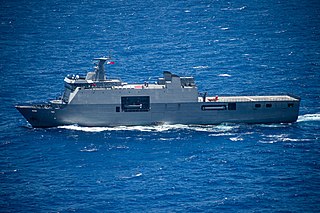A ship prefix is a combination of letters, usually abbreviations, used in front of the name of a civilian or naval ship that has historically served numerous purposes, such as identifying the vessel's mode of propulsion, purpose, or ownership/nationality. In the modern environment, prefixes are cited inconsistently in civilian service, whereas in government service a vessel's prefix is seldom omitted due to government regulations dictating that a certain prefix be used. Today the common practice is to use a single prefix for all warships of a nation's navy, and other prefixes for auxiliaries and ships of allied services, such as coast guards. For example, the modern navy of Japan adopts the prefix "JS" – Japanese Ship. However, not all navies use prefixes. Among the blue-water navies, those of France, Brazil, China, Russia, Germany, and Spain do not use ship prefixes. NATO designations such as FS, FGS, and SPS can be used if needed.

An amphibious transport dock, also called a landing platform dock (LPD), is an amphibious warfare ship, a warship that embarks, transports, and lands elements of a landing force for expeditionary warfare missions. Several navies currently operate this kind of ship. The ships are generally designed to transport troops into a war zone by sea, primarily using landing craft, although invariably they also have the capability to operate transport helicopters.

The Philippine Navy (PN) is the naval warfare service branch of the Armed Forces of the Philippines. It has an estimated strength of 24,500 active service personnel, including the 10,300-strong Philippine Marine Corps. It operates 82 combat vessels, 14 auxiliary vessels, 25 manned aircraft and 8 unmanned aerial vehicles. Tracing its roots from the Philippine Revolutionary Navy on May 20, 1898, while its modern foundations were created during the creation of the Offshore Patrol in February 9, 1939, the PN is currently responsible for naval warfare operations and maritime patrol missions within the Philippine Waters, as well as ensuring the protection of the Philippine's maritime interests, including the West Philippine Sea and Benham Rise.

The Balikpapan class is a ship class of eight heavy landing craft. All eight were originally laid down by Walkers Limited for the Australian Army in the early 1970s. A reorganisation of watercraft responsibilities in the Australian military meant the landing craft were to be operated by the Royal Australian Navy (RAN), with seven commissioned directly into RAN service during 1973 and 1974, and lead ship Balikpapan transferred from the army to the navy. During the leadup to the independence of Papua New Guinea in 1975, two of the vessels were transferred to the new Papua New Guinea Defence Force (PNGDF).

The Indonesian Navy is the naval branch of the Indonesian National Armed Forces. It was founded on 10 September 1945 and has a role to patrol Indonesia's lengthy coastline, to enforce and patrol the territorial waters and Exclusive Economic Zone (EEZ) of Indonesia, to protect Indonesia's maritime strategic interests, to protect the islands surrounding Indonesia, and to defend against seaborne threats.

The Makassar class is a class of South Korean-designed Landing Platform Dock. The lead ship is named after the city of Makassar in Sulawesi and built in Busan, South Korea. The ships were designed by Daesun Shipbuilding & Engineering Co. based on their earlier design of Tanjung Dalpele class that was sold to the Indonesian Navy.

The Armed Forces of the Philippines (AFP) Modernization Act, officially designated as Republic Act No. 7898, was a Philippine law that was enacted on February 23, 1995, by President Fidel V. Ramos. It was aimed to modernize all branches of the Armed Forces of the Philippines (AFP) such as the Philippine Air Force, Philippine Navy, and the Philippine Army. The law was amended by Republic Act No. 10349, also known as the Revised AFP Modernization Act, on December 11, 2012.

BRP Ivatan (LC-298) is a Balikpapan-class heavy landing craft operated by the Philippine Navy. One of eight vessels built by Walkers Limited for the Royal Australian Navy (RAN), the ship was commissioned into Australian service in 1973 as HMAS Brunei. During her RAN career, Brunei visited Lord Howe Island, was deployed post-Cyclone Tracy as part of Operation Navy Help Darwin, performed coastal surveys of northern Australia and Papua New Guinea, and served as part of the INTERFET peacekeeping taskforce.

BRP Batak (LC-299) is a Balikpapan-class heavy landing craft operated by the Philippine Navy. One of eight vessels built by Walkers Limited for the Royal Australian Navy (RAN), the ship was commissioned into Australian service in 1973 as HMAS Tarakan. During her RAN career, Tarakan was deployed post-Cyclone Tracy as part of Operation Navy Help Darwin, undertook various surveying operations, was placed in reserve between 1985 and 1988, relocated an overpopulation of Tridacna gigas clams, was part of the INTERFET peacekeeping taskforce, and participated in a Pacific Partnership humanitarian deployment.

BRP Tarlac (LD-601) is the lead ship of her class of landing platform docks in service with the Philippine Navy. She is the second ship to be named after the Philippine province of Tarlac, one of the provinces considered to have significant involvement in the Philippine Revolution of independence against Spain.

PT PAL Indonesia is an Indonesian state-owned enterprise that manufactures ships for military and civilian use and conducts repairs and maintenance on ships and engineering.
Multi-Role Support Ship (MRSS) is a class of amphibious ship planned for the Royal Malaysian Navy (RMN).

KRI Semarang(594) is an Indonesian Navy hospital ship converted from the fifth Makassar-class landing platform dock of the Indonesian Navy.

KRI Makassar (590) is the lead ship of the Makassar-class landing platform dock of the Indonesian Navy.

KRI Surabaya (591) is the second ship of the Makassar-class landing platform dock of the Indonesian Navy.

KRI Banjarmasin (592) is the third ship of the Makassar-class landing platform dock of the Indonesian Navy.

KRI Banda Aceh (593) is the fourth ship of the Makassar-class landing platform dock of the Indonesian Navy.

The Philippine Navy's new 124-meter Landing Platform Dock is a class of two ships being constructed by PT PAL Indonesia for the navy's Landing Dock Acquisition Project. The class is an improvement on the previously commissioned Tarlac-class which was also constructed by PT PAL. The ships are being acquired as part of Horizon 2 of the Revised AFP Modernization Program, which was set to cover the period of 2018 to 2022.

















